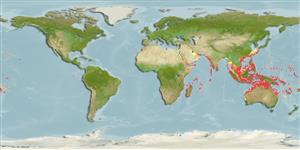Actinopterygii (ray-finned fishes) >
Perciformes (Perch-likes) >
Lethrinidae (Emperors or scavengers) > Lethrininae
Etymology: Lethrinus: Greek, lethrinia, a fish pertaining to genus Pagellus.
Environment / Climate / Range
Ecology
Marine; brackish; reef-associated; non-migratory; depth range 10 - 90 m (Ref. 6390). Tropical, preferred 28°C (Ref. 107945); 32°N - 35°S, 24°E - 167°W
Indo-West Pacific: widespread, from the Red Sea, Arabian (Persian) Gulf, and East Africa to the Ryukyus and Tonga.
Length at first maturity / Size / Weight / Age
Maturity: Lm 27.7, range 18 - ? cm
Max length : 52.0 cm TL male/unsexed; (Ref. 1020); common length : 40.0 cm TL male/unsexed; (Ref. 5450); max. reported age: 19 years (Ref. 42001)
Dorsal
spines
(total): 10;
Dorsal
soft rays
(total): 9;
Anal
spines: 3;
Anal
soft rays: 8. Mouth is slightly protractile; lips thick and fleshy. The inner base of the pectoral fin is either with few scales or naked. Body olive-green above, becoming paler below; each scale on back sometimes with white center. The posterior margin of the opercle and sometimes the base of the pectoral fin is red. The pectoral fin is white, yellow or pinkish; the pelvic and anal fins are white to orange; the dorsal fin is white and orange mottled with a reddish margin; the caudal fin is mottled orange or reddish.
Inhabits sandy bottoms in coastal areas, deep lagoons and near coral reefs (Ref. 30573). Juveniles and small adults commonly in loose aggregations over seagrass beds, mangrove swamps and shallow sandy areas while adults are generally solitary in deeper waters. Feeds primarily on crustaceans and mollusks but echinoderms, polychaetes and fishes are also consumed in considerable quantities (Ref. 2295). A protogynous hermaphrodite (Ref. 55367).
A monandric species (Ref. 55367). Length at sex change = 30.8 cm TL (Ref. 55367). Also Ref. 103751.
Carpenter, K.E. and G.R. Allen, 1989. FAO Species Catalogue. Vol. 9. Emperor fishes and large-eye breams of the world (family Lethrinidae). An annotated and illustrated catalogue of lethrinid species known to date. FAO Fish. Synop. 125(9):118 p. Rome: FAO. (Ref. 2295)
IUCN Red List Status (Ref. 115185)
CITES (Ref. 94142)
Not Evaluated
Threat to humans
Harmless
Human uses
Fisheries: highly commercial
More information
ReferencesAquacultureAquaculture profileStrainsGeneticsAllele frequenciesHeritabilityDiseasesProcessingMass conversion
Tools
Special reports
Download XML
Internet sources
